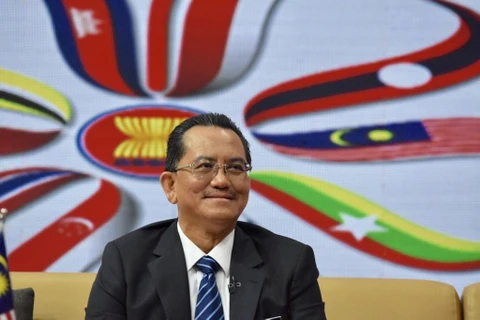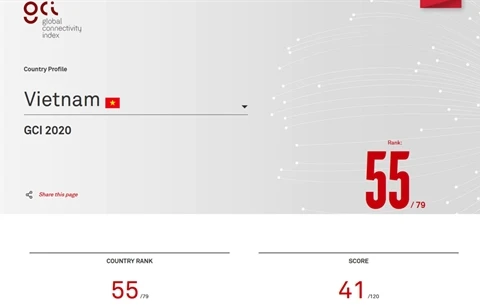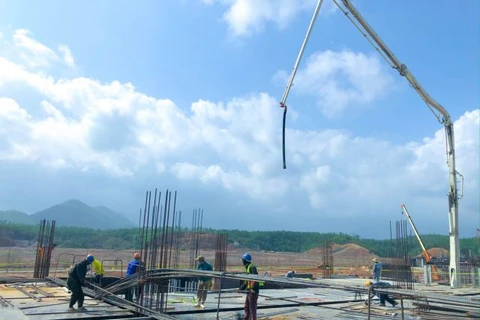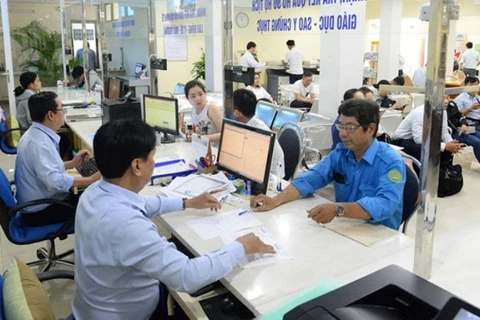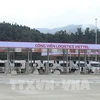 Deputy Minister of Information and Communications Phan Tam delivers a remark at the opening session of the World Mobile Broadband & ICT 2021 in Hanoi on March 25. (Photo: VietnamPlus)
Deputy Minister of Information and Communications Phan Tam delivers a remark at the opening session of the World Mobile Broadband & ICT 2021 in Hanoi on March 25. (Photo: VietnamPlus)Hanoi (VNA) - The contribution of 5G to the national GDP growth is forecast to reach 7.34 percent by 2025, the World Mobile Broadband & ICT 2021 conference was told in Hanoi on March 25.
This is an important forum for telecommunications managers and experts to promote the development of services in the Vietnamese market. The theme of this year is developing 5G and broadband infrastructure to enhance the digital transformation process in Vietnam.
The report "e-Conomy SEA 2020”, which is conducted by Google, Temasek and Bain & Company, showed that Vietnam's digital economy reached a total value of 14 billion USD last year, 2 billion USD higher than that of the same period of the previous year.
Of the total number of digital service users in Vietnam, new users account for 41 percent, making Vietnam a country with the highest rate of new digital service consumers in the region.
Statistics from the General Statistics Office said that Vietnam was one of the three Asian countries with positive growth with the size of the economy exceeding 343 billion USD. That of Singapore reached 337.5 billion USD and Malaysia 336.3 billion USD.
The Vietnamese Government has defined the telecommunications infrastructure, including both mobile and fixed broadband infrastructure, as one of the pillars of the digital economy.
The development of broadband infrastructure has paved the way for all other economic sectors to grow within the past two to three years.
By the end of last month, the total number of fixed broadband subscribers in Vietnam exceeded 17.2 million, and that of mobile broadband subscribers reached nearly 69.5 million, reported the Vietnam Telecommunications Authority.
However, Vietnam needs more innovations in order to realise the national digital transformation project by 2030 and further promote the digital economy, telecommunication investment and exploitation activities in the country.
Highlighting the development of Vietnam's telecommunications market, Tran Duc Lai, chairman of the Radio and Electronics Association of Vietnam, said operators had launched 5G services and achieved very positive results last year.
The country will test 5G on a large scale and even with Make-in-Vietnam devices from this year. It is paying particular attention to applying 5G in hi-tech agriculture and industry.
In his remarks at the opening session, Deputy Minister of Information and Communications Phan Tam said that Vietnam is entering a digital age and digital society.
The world would witness more major changes over the next 10 years, he said, adding that it was a transition from the real to the virtual world and the transformation of all socio-economic activities into a digital environment.
Data would become a critical resource to every country, fuelling the robust growth of the Internet of Things, he added.
Tam went on to say that telecom infrastructure has been fundamental to the digital economy, digital society and e-government. Mobile and fixed broadband infrastructures are greatly contributing to the development of the country.
A study by the National Institute of Information and Communications Strategy said that the contribution of 5G to the national GDP growth is forecast to reach 7.34 percent by 2025.
Digital transformation, telecommunications, digital technology, e-government, and digital skills are repeatedly highlighted in the socio-economic development strategy for the 2021-2030 period and the socio-economic development plan for the next five years.
Science, technology, innovation and digital transformation are some of the strategic breakthroughs of the next decade to help Vietnam make to the upper-middle-income countries by 2030 and high-income industrial countries in 2045.
To this end, the Ministry of Information and Communications is determined to keep pace with the world and be proactive in deploying commercialisation of 5G in Vietnam./.


